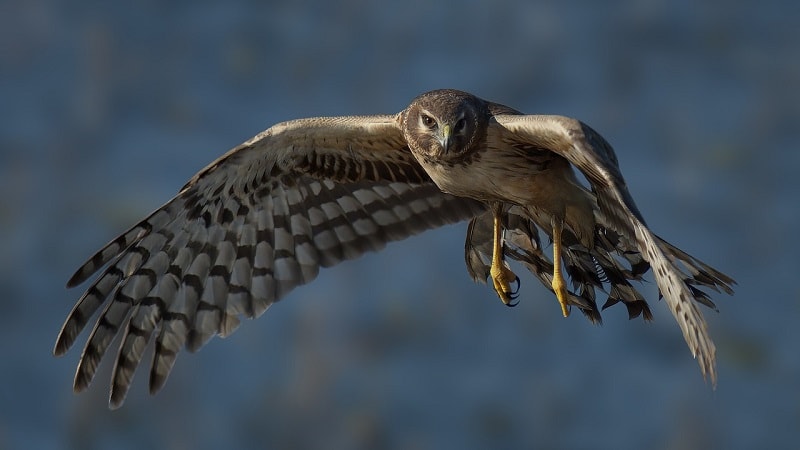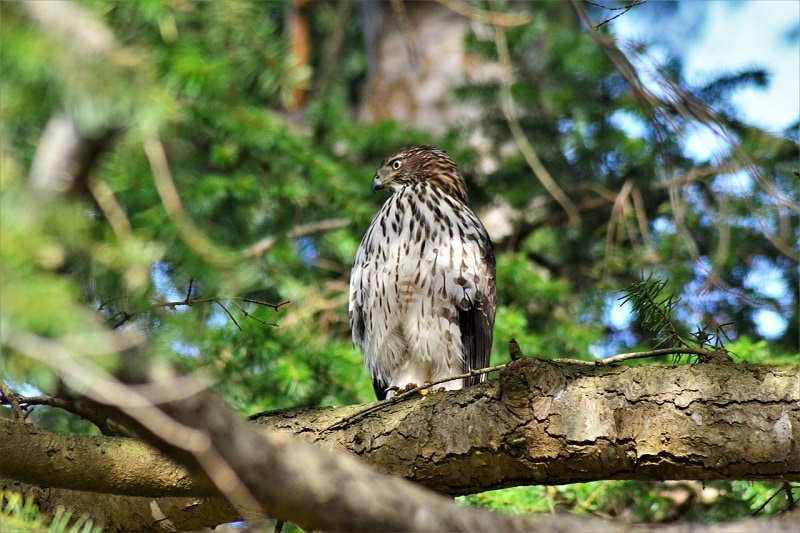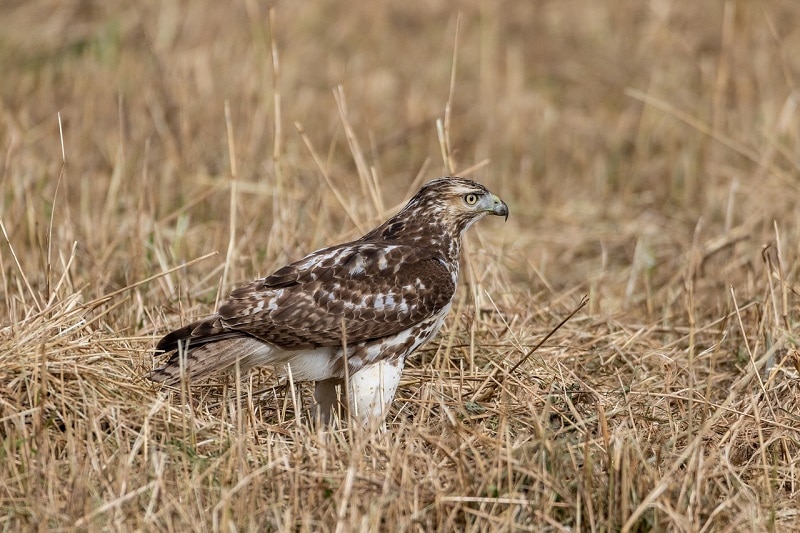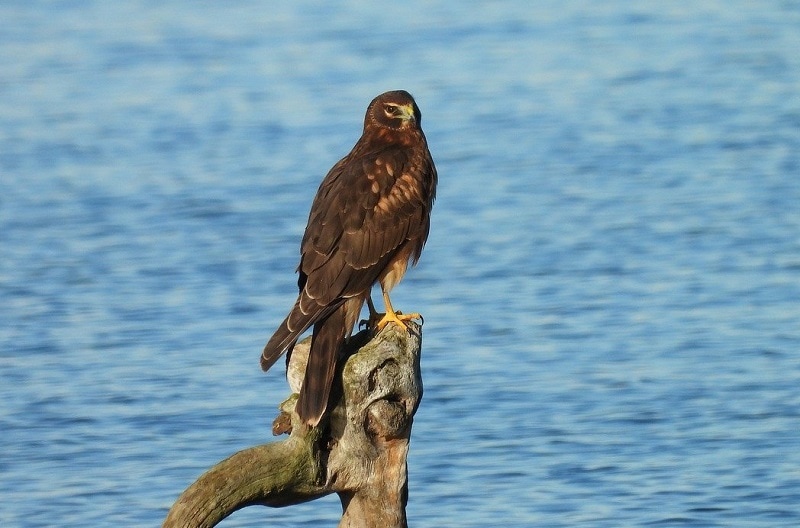8 Species of Hawks in Michigan (With Pictures & Info)
Last Updated on

Hawks are majestic creatures, and Michigan is home to eight of them year-round. Known for their hunting skills and agility, they soar the skies with ease. However, some hawks on this list are losing their habitat because of deforestation.

1. Sharp-shinned Hawk

Coming in at the smallest hawk species in Michigan, we have the Sharp-shinned hawk. These are a year-round resident to the state but primarily use the northern tip for breeding. During migration, you can see these birds throughout the United States as they head towards the breeding grounds.
When it comes to identifying this bird, they stand out with their distinctive method of flying. When they fly, they use a flap and glide method. They are also incredibly athletic birds that dive and swoop down to catch their prey. For dinner time they prefer song birds, which if you have a bird feeder you’ve probably heard the warning calls before one of them gets swooped away.
You’ll know it is the sharp-shinned hawk by the bars of orange on their upper chest that fades at the belly and the bluish-gray back and wings. Females are going to be larger than males by a considerable amount.
- Length: 9.4–13.4 in
- Weight: 3.1–7.7 oz
- Wingspan: 16.9–22.1 in
2. Broad-winged Hawk

The Broad-winged Hawk is found in most of the eastern United States. You can commonly see them around the Great Lakes during the spring and fall migration times. Unlike other hawk species, they migrate in groups which are called kettles. These groups can be week into the thousands.
These birds are found in the woods away from humans. The best time to see them is the migrations they make in the fall. These birds travel south over 4,000 miles one way to get to Central America.
Unlike other raptor species, these birds don’t like to hunt while flying. They prefer to wait patiently to swoop down to capture a small mammal, frog, or toad.
These birds share the same coloring between males and females, but females are often larger. The dark back with white peeking out of the wings and speckled body make them easy to spot.
- Length: 13.4–17.3 in
- Weight: 9.3–19.8 oz
- Wingspan: 31.9–39.4 in
3. Cooper’s Hawk

At the third smallest hawk there is the Cooper’s Hawk. This bird if seen all year through the southern part of Michigan while only seen in the north half during breeding season. Most of this species will stay in the southern half or head all the way to Northern Mexico to breed.
Because these hawks are incredibly athletic, they can often be seen in backyards around bird feeders. Many people dislike this hawk for taking the songbirds, but they are a sight to see. While most hawks have been hurt by the destruction of habitat, the Cooper Hawk isn’t. Thanks to the smaller area, their prey is now easier than ever to find.
Cooper’s look almost identical to the Sharp-shinned hawk. They have the same markings, including the little black cap on the top of the head. The easiest way to tell the difference is size. Copper’s are larger, but that difference can’t easily be seen if the birds are flying.
- Length: 14.6–17.7 in
- Weight: 7.8–24.0 oz
- Wingspan: 24.4–35.4 in
4. Red-shouldered Hawk

Here is the Red-shouldered Hawk, which can be found in most parts of the eastern United States and coastal areas of California. For Michigan, it is like most hawks on this list. They are seen year-round in the southern half of the state and only in the north half during breeding season.
If you are looking for markings, these hawks have one very distinctive feature. They have red shoulders that are visible when perched and while flying. They also have very strong banding across their tail and mostly white underwings.
With hunting, these birds favor wooded areas away from humans. However, because of their habitat being destroyed, they are slowly being seen in suburban areas that meet woodlands. Their primary source of prey for these birds is small mammals like squirrels and rabbits. They will eat snakes, lizards, and amphibians if food is limited. During a hunt these birds drop onto their prey from directly above, making it a unique style among birds.
- Length: 16.9–24.0 in
- Weight: 17.1–27.3 oz
- Wingspan: 37.0–43.7 in
5. Red-tailed Hawk

You will find the Red-tailed Hawk living in the southern half of Michigan year-round and traveling to the north for breeding. Out of all the hawks on this list, the Red-tailed Hawk is the most common in the state, and the one people are the most familiar with.
The best place to see these large raptors is on the highway. The nickname for these birds is the “roadside hawk” because of their unique hunting method. Unlike other hawks, this bird has adapted to the human presence and intervention of their habitat. They use the prime hunting area of the road to swoop down and catch their prey while it’s distracted by highway traffic. A meal for this species is commonly rodents, snakes, or even other birds.
The signature red tail can identify these raptors. The rest of their plumage can vary from nearly white all the way to black. You will know the males from the females due to size.
Red-tailed hawks mate for life and prefer nesting in the tallest of tress that best give a view. Because of deforestation they have adapted to making nests on billboards, window ledges, or even the sides of tall buildings.
- Length: 17.7–25.6 in
- Weight: 24.3–51.5 oz
- Wingspan: 44.9–52.4 in
6. Rough-legged Hawk

The Rough-legged Hawk is named for the feathering pattern on the legs. The feathered legs help conserve heat when they are in the arctic tundra to breed. You won’t see this species in the United States till winter hits. They have a non-breeding distribution over the entire state of Michigan, which makes them a common sight in the winter.
These birds prefer to hunt by hovering as they face the wind, looking for their prey. They are one of the few birds of prey that truly hover in place as they hunt. Lemmings are the preferred food for these creatures, but when they travel south, they eat other small rodents.
Unlike other hawk species, they stay in larger groups. If you see one, there is often another close by. Airports and agricultural land are where these birds will often be seen nesting. With their size, they truly are a hazard to planes.
- Length: 18.5–20.5 in
- Weight: 25.2–49.4 oz
- Wingspan: 52.0–54.3 in
7. Northern Harrier

Like the rest of this list, the Northern Harrier can be found in the southern half of Michigan year-round while only in the northern half in breeding season. They prefer open areas of land like fields and marshes, but with the habitat loss fields are becoming more common.
The easiest way to spot the Northern Harrier is the owlish face, the white patch on their tail feathers, and their gliding style. They put their wings in a V shape as they glide across areas while hunting.
Unlike the other hawk species on this list, Harriers rely on their sense of hearing to capture their prey. While their sight is amazing, they have far better hearing, allowing them to find prey even in heavily wooded areas.
- Length: 18.1–19.7 in
- Weight: 10.6–26.5 oz
- Wingspan: 40.2–46.5 in
8. Northern Goshawk

Like the name Northern Goshawk suggests, this bird lives up north and holds a denser population the further you go. There is a large population in Central Michigan and breed from Roscommon County northward during breeding season.
In the state of Michigan, this hawk is conserved to be of special concern. They are lacking in numbers, but currently there are no legal protections for them. Because of habitat loss, they truly are suffering since their preferred space is deep in forests.
Out of all the hawks on this list, this bird gets defensive around humans. They will attack if they feel like there is danger. With the loss of their home, they have moved towards rivers to stay away from humans. Thankfully, this hawk is an opportunistic hunter and will eat a variety of foods.
- Length: 20.9–25.2 in
- Weight: 22.3–48.1 oz
- Wingspan: 40.5–46.1 in

Summary
Now you know all about the eight different hawks that make Michigan its home. While some are deep in the woods, others make their home right in your backyard. Keep an eye out and you may notice more around you than you ever thought were there.
Check out some of our top-ranking posts:
- 9 Species of Hawks in Ohio (with Pictures)
- 9 Hawk Species Found in Florida
- 17 Finch Species Found in the United States
- 20 Types of Ducks in Michigan (With Pictures)
Featured Image Credit: iulian_ursache, Pixabay
About the Author Robert Sparks
Robert’s obsession with all things optical started early in life, when his optician father would bring home prototypes for Robert to play with. Nowadays, Robert is dedicated to helping others find the right optics for their needs. His hobbies include astronomy, astrophysics, and model building. Originally from Newark, NJ, he resides in Santa Fe, New Mexico, where the nighttime skies are filled with glittering stars.
Related Articles:
Monocular vs Telescope: Differences Explained (With Pictures)
How to Clean a Refractor Telescope: Step-by-Step Guide
How to Clean a Telescope Eyepiece: Step-by-Step Guide
How to Clean a Rifle Scope: 8 Expert Tips
What Is a Monocular Used For? 8 Common Functions
How to Clean a Telescope Mirror: 8 Expert Tips
Brightfield vs Phase Contrast Microscopy: The Differences Explained
SkyCamHD Drone Review: Pros, Cons, FAQ, & Verdict
